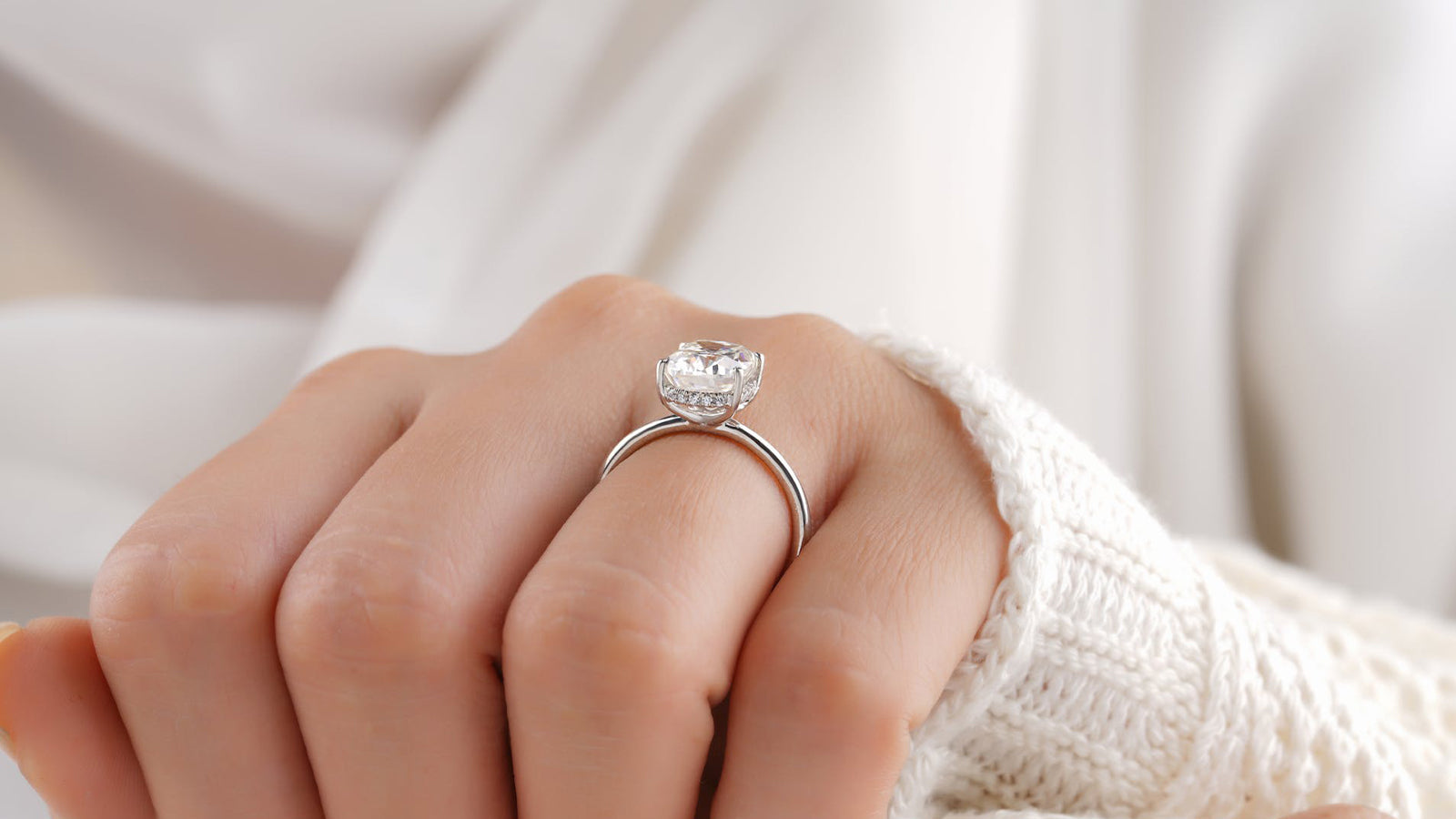
ENGAGEMENT AND WEDDING RING METAL GUIDE
An engagement ring is such a precious symbol of your love, which is why every facet of the ring needs to be carefully considered to ensure it best reflects her unique personality. One of the features to think about is the type of metal. The three types of metals for rings that Shimansky’s master craftsmen work with include platinum, 18k gold and palladium. All of these precious metals are exquisite, and valuable and have their distinct benefits. Aside from the visual preference for the metals, there are many other factors to consider when choosing one over the other.
Our ring metal guide is here to help you make an informed decision. Aside from a comprehensive ring metal comparison, our guide answers common questions around engagement ring metals – like what is the strongest metal for rings, the hypoallergenic ring materials that are available, the rare metals for rings, should wedding ring metals match and what ring metals can be resized. So, before we explore the different types of metals for rings, let’s start by answering these questions.
WHAT IS THE BEST METAL FOR A RING?
Many couples ask us what is the best metal for a ring. What is best for you as a couple will differ from what’s best for someone else, depending entirely on the qualities you value in a ring. When it comes to engagement ring metals and wedding ring metals, one thing is certain: Shimansky only uses the purest and most precious metals to craft their beautiful creations. These metals include platinum, palladium and 18k white, yellow or rose gold.

WHAT RING METALS CAN BE RESIZED?
Pairing rose gold, yellow gold and white gold is one of the biggest engagement ring and wedding jewelry trends at the moment. An engagement ring designed with different metals will complement a wedding band designed with the same metals beautifully. However, when it comes to two different metals that are very similar in tone, such as platinum and palladium, we recommend that you stick to one or the other.

PLATINUM – SHIMANSKY’S STRONGEST METAL FOR RINGS
Since Shimansky pioneered the use of platinum in South Africa, this precious metal has taken the jewelry industry by storm. This highly sought-after material is the strongest metal for rings in the Shimansky showroom, and one of the most popular engagement ring metals and wedding ring metals in the world. Platinum is the perfect choice for pieces that are worn daily and require durability to stand the test of time. Due to platinum’s hardness, Shimansky uses 95% pure platinum with a small amount of other metals to make it more pliable for casting and less brittle.
ADVANTAGES
- Platinum is resistant to corrosion and oxidation.
- Platinum is one of the best hypoallergenic ring materials and can be worn by those with sensitive skin or skin allergies.
- Platinum is the most durable and strongest precious metal used to create Shimansky’s highly sought-after jewelry and one of the most secure engagement ring metals for delicate settings.
- Platinum does not wear thinner over time. If scratched, the metal is merely displaced and can be polished back to its original shine.
- Platinum will not tarnish and needs less maintenance, compared to other metals.
- Platinum’s remarkable natural light color brings out a diamond’s shine magnificently.
DISADVANTAGES
- Due to its scarcity and exclusivity, platinum is a bit more expensive than gold and palladium. However, in the long run, platinum requires less maintenance, which may outweigh the initial extra cost.
GOLD – BEAUTY IN VARIETY
Gold is a traditional choice that is still very popular today. This relatively soft metal requires the addition of alloys like nickel, silver, zinc, manganese, palladium or copper to add strength. Gold is naturally yellow. By adding different alloys, jewelers can create beautiful pinkish rose gold or bright white gold, giving brides-to-be an array of different types of gold engagement rings to choose from.
ADVANTAGES
- Gold does not rust, tarnish or corrode.
- Yellow gold and rose gold won't lose their color over time.
- If you’re on a budget, gold can be a more affordable option than platinum.
- There are more types of gold engagement rings to choose from than rings made from any other metal. The variety in terms of color allows brides-to-be greater freedom of choice.
- Trendy – rose gold, white gold and yellow gold can be combined for a more contemporary look.
- Gold is less dense than platinum and therefore lighter, which makes it easier to wear when it comes to larger pieces.
DISADVANTAGES
- The nickel present in the gold alloy may not be suitable for metal allergy sufferers.
- Requires more maintenance – white gold needs regular rhodium plating to maintain its bright white shine.
- Wears down over time – small scratches on the surface will remove microscopic amounts of the metal, as opposed to platinum and palladium where the metal is only displaced.

PALLADIUM – THE EXTRAORDINARY RARITY
Platinum is more rare than gold. It’s so rare that all of the platinum ever mined could fit into your living room. Palladium, however, is even scarcer. This exquisite silver-white metal is 15 times more rare than platinum. If rare metals for rings fascinate you then palladium might be a sterling choice for your engagement ring.
Palladium is very similar to its cousin, platinum. Both of these noble metals are hypoallergenic, durable, extremely comfortable and require minimum maintenance. The main differences are in weight and price. Palladium is by nature a less dense metal than platinum and gold, which means that fewer grams of the metal are required for a piece of jewelry. This means that palladium engagement rings are not only lighter but also cost less than platinum and gold engagement rings.
ADVANTAGES
- Minimum maintenance – like platinum, palladium is a naturally white metal and does not need to be rhodium plated like white gold.
- Durable – palladium engagement rings and wedding bands are strong and will stand the test of time.
- Palladium engagement rings cost less than platinum and gold engagement rings due to the metal’s low density and jewelers needing less grams of it to create an item.
- Does not wear down – like platinum, palladium has what is called a ‘fluid surface’. When palladium gets scratched the metal is actually just displaced as opposed to being removed like gold.
DISADVANTAGES
- Weight- Palladium weighs less than platinum due to its lower density, and some people value the more substantial weight of platinum.
- Availability – palladium is difficult to work with by hand, therefore not many jewelers are knowledgeable and equipped to work with it, therefore palladium jewelry is not widely available.

We invite you to visit your nearest Shimansky showroom and view our collection of engagement rings and wedding bands. Here at Shimansky we only use the purest precious metals in crafting our exquisite diamond creations, including platinum, palladium and 18k white, yellow and rose gold. When acquiring your perfect Shimansky diamond ring you can rest assured that your diamond is securely set in resilient metal that is both elegant and everlasting – just like your love for each other.








Leave a comment
This site is protected by hCaptcha and the hCaptcha Privacy Policy and Terms of Service apply.